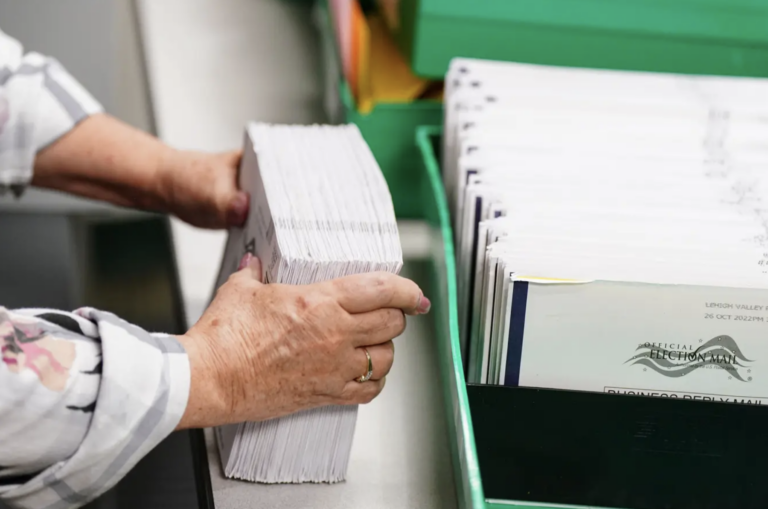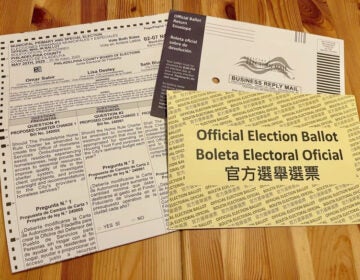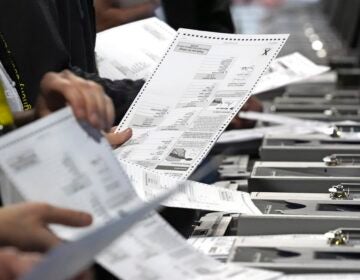Pa. primary election 2023: Everything you need to know about requesting, filling out, and returning your mail ballot
All Pa. voters will have a chance to vote by mail. But thanks to the state's patchwork of mail voting regulations, their experiences may differ slightly from county to county.

Mail ballots are sorted and counted in Allentown, Lehigh County, Pennsylvania on Election Day November 2022. (Matt Smith for Spotlight PA)
What questions do you have about the 2023 elections? What major issues do you want candidates to address? Let us know.
This story originally appeared on Spotlight PA.
Voters in Pennsylvania’s May 16 primary election will choose their parties’ statewide candidates for the Commonwealth, Superior, and Supreme Courts, plus a slew of candidates in local races for mayor, council, school boards, and more.
All of these voters will have a chance to cast their ballots by mail. But thanks to Pennsylvania’s patchwork of mail voting regulations, their experiences may differ slightly county to county.
The commonwealth dramatically expanded mail voting in 2019, allowing all registered voters to request mail ballots without an excuse.
But since then, mail voting has become highly politicized. During and after the elections since the expansion, lawsuit after lawsuit has contested different parts of Pennsylvania’s mail voting law and, in some cases, the practice in its entirety.
The law as a whole has withstood attempts to overturn it. But in recent years, courts have tweaked and clarified several of its key components — sometimes in ways that allow counties to determine their own rules.
For instance, where some counties previously accepted mail ballots with missing or incorrect dates on their outer envelopes, the state Supreme Court ruled last year that the practice is no longer permitted. Ballots will also be declared invalid if they’re missing their inner “secrecy envelope.”
Some counties will contact voters if their mail ballots have disqualifying problems such as missing dates or signatures. But that practice isn’t regulated across the commonwealth, so each county does it slightly differently, and many don’t allow ballot curing at all. Counties can also make their own rules about drop boxes. They’re allowed, but not required, and counties can use any number of them they want.
With that slightly complicated legal landscape in mind, here’s everything you need to know about voting by mail in the May 2023 primary election.
How do I request a mail ballot?
You can apply for a mail ballot online, in person at a county election office, or through the mail. Applications must be received by your county by 5 p.m. May 9.
(If you’re not already registered to vote, you must do so by May 1. Online voter registration applications must be submitted by 11:59 p.m that day. Mail and in-person applications must be received by the county board of elections by close of business.)
You must provide proper identification to apply for a mail ballot. Acceptable options include a Pennsylvania driver’s license or other state-issued ID, or the last four digits of a Social Security number. The Department of State lists the approved forms of identification online.
You can either apply for a one-time mail ballot or to be added to the annual request list, which means you’ll get an application each year.
How do I make sure my ballot is counted?
The best way to ensure your vote counts is to follow the rules, and make sure you’re up to date on exactly what those rules are.
Each mail ballot comes with instructions that voters must read carefully.
- Ballots come with two envelopes: an inner “secrecy” envelope and an outer envelope. Ballots must be sealed in the inner envelope, and you cannot write on these.
- Once you’ve properly sealed the inner envelope, place it in the outer envelope and seal.
- There’s a voter declaration on the outer envelope. You must sign and date below the declaration. Make sure your date is accurate, and follows the standard U.S. month-day-year format.
- Some counties require paid postage, but others don’t. Check your county election website to confirm.
If you realize you messed your ballot up in some way, you have a few options.
If you haven’t yet returned the ballot, you can contact your county election office and the county may be able to declare the ballot damaged and send a new one.
Even if you have submitted your ballot, some counties allow ballot “curing” — that is, allowing eligible voters to fix minor errors that would invalidate their ballot. Some counties proactively contact voters if they notice errors, some require voters to reach out, and some don’t allow curing at all. You can use this Spotlight PA tool to check your own county’s policy.
And regardless of your county’s policy, you always have a failsafe.
If you have any reason to worry about your ballot — it might have a disqualifying problem, you never received one and didn’t request a replacement, or you never got word that the county received your mailed ballot — you can always go to the polls in person and request to vote by provisional ballot. If the state doesn’t receive a mail ballot from you, your provisional vote will be counted.
How do I return my mail ballot?
You have a few different options for turning in your ballot, but the most important thing to remember is that your county election board must receive it by 8 p.m. on Election Day.
You can mail a ballot from anywhere, but if you’re dropping it off in person or using a drop box, you must use a location within your county or it won’t be counted.
If you plan to:
- Return your ballot by mail: To return your ballot through the mail, all you have to do is use the proper postage and mail it out the same way you’d send any mail. Because counties cannot count ballots that come in after 8 p.m. on Election Day, the sooner you mail your ballot, the better.
- Deliver your ballot in person: Make sure your ballot has been properly filled out and sealed, then return the ballot in person to your county election office. Some counties may also have other designated return sites. If that’s the case, you can find the address here.
- Use a drop box: Drop boxes can be an easy way to make sure your mail ballot arrives before the deadline without having to travel all the way to a county election office. They’re used inconsistently across the commonwealth; a Spotlight PA review found that 40 of Pennsylvania’s 67 counties have none, and of the 27 that do, 15 have only one. Voters should look on their county’s website to find an official list of locations.
If you have a disability that prevents you from returning your own ballot, you may fill out a form to designate someone else to return it for you. You must turn in the form with your mail ballot application, and the designee must have a copy on hand when they return your ballot. Otherwise, you must return your own ballot.
Politicians have used isolated instances of illegal ballot returns to challenge the security of mail voting, but these incidents do not indicate widespread fraudulent voting. Mail ballot fraud is rare because of the identity checks involved in requesting a mail ballot and the security measures that are required in order to count each one.
Visit vote.pa.gov to read the Department of State’s rules for mail ballots.

Get daily updates from WHYY News!
WHYY is your source for fact-based, in-depth journalism and information. As a nonprofit organization, we rely on financial support from readers like you. Please give today.





